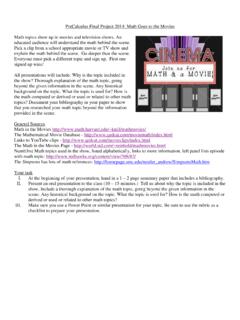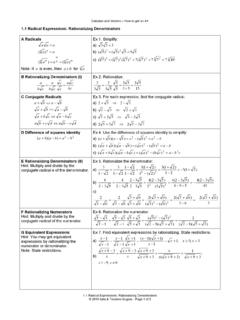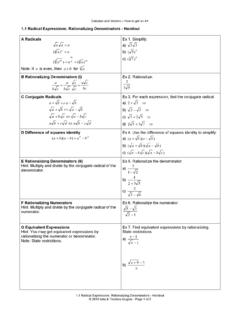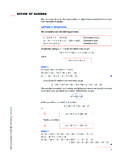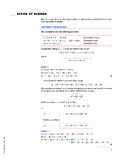Transcription of AP Calculus – Final Review Sheet
1 AP Calculus Final Review Sheet When you see the words .. This is what you think of doing 1. Find the zeros Find roots. Set function = 0, factor or use quadratic equation if quadratic, graph to find zeros on calculator 2. Show that ()xf is even Show that ()()xfxf= symmetric to y-axis 3. Show that ()xf is odd Show that ()()xfxf = OR ()()fxfx= symmetric around the origin 4. Show that ()xfax lim exists Show that limx a fx()=limx a+fx(); exists and are equal 5. Find ()xfax lim, calculator allowed Use TABLE [ASK], find y values for x-values close to a from left and right 6. Find ()xfax lim, no calculator Substitute x = a 1) limit is value if bc, incl. 00;0cc= 2) DNE for 0b 3) 00 DO MORE WORK! a) rationalize radicals b) simplify complex fractions c) factor/reduce d) known trig limits 1. 0sinlim1xxx = 2. 01coslim0xxx = e) piece-wise fcn: check if RH = LH at break 7. Find ()limxfx , calculator allowed Use TABLE [ASK], find y values for large values of x, 999999999999 8.
2 Find ()limxfx , no calculator Ratios of rates of changes 1)fastDNEslow= 2) 0slowfast= 3) sameratiosame=of coefficients 9. Find horizontal asymptotes of ()xf Find ()xfx lim and ()xfx lim 10. Find vertical asymptotes of ()xf Find where ()limxafx = 1) Factor/reduce ()xf and set denominator = 0 2) lnx has VA at x = 0 11. Find domain of ()xf Assume domain is , (). Restrictable domains: denominators 0, square roots of only non-negative numbers, log or ln of only positive numbers, real-world constraints 12. Show that ()xf is continuous Show that 1) ()xfax lim exists ( limx a fx()=limx a+fx()) 2) ()af exists 3) ()()afxfax= lim 13. Find the slope of the tangent line to ()xf at x = a. Find derivative ()maf= 14. Find equation of the line tangent to ()xf at (),ab ()maf= and use ()yb mxa = sometimes need to find ()bfa= 15. Find equation of the line normal (perpendicular) to ()xf at (),ab Same as above but ()afm =1 16.
3 Find the average rate of change of ()xf on []ba, Find ()()abafbf 17. Show that there exists a c in []ba, such that ()fcn= Intermediate Value Theorem (IVT) Confirm that ()xf is continuous on[]ba,, then show that ()()fanfb . 18. Find the interval where ()xf is increasing Find ()xf , set both numerator and denominator to zero to find critical points, make sign chart of ()xf and determine where ()xf is positive. 19. Find interval where the slope of ()xf is increasing Find the derivative of()()xfxf = , set both numerator and denominator to zero to find critical points, make sign chart of ()xf and determine where ()xf is positive. 20. Find instantaneous rate of change of()xf at a Find ()af 21. Given ()ts (position function), find ()tv Find ()()tstv = 22. Find ()xf by the limit definition Frequently asked backwards ()()()()() ()0lim orlimhxafx h fxfxhfx fafaxa + = = 23. Find the average velocity of a particle on []ba, Find ()() ()1 OR basb savt dtbaba depending on if you know ()vt or ()st 24.
4 Given ()tv, determine if a particle is speeding up at tk= Find ()vkand ()ak. If signs match, the particle is speeding up; if different signs, then the particle is slowing down. 25. Given a graph of ()xf , find where ()xf is increasing Determine where ()xf is positive (above the x-axis.) 26. Given a table of x and ()xf on selected values between a and b, estimate ()cf where c is between a and b. Straddle c, using a value, k, greater than c and a value, h, less than c. so ()()()hkhfkfcf 27. Given a graph of()xf , find where ()xf has a relative maximum. Identify where ()0fx = crosses the x-axis from above to below OR where ()xf is discontinuous and jumps from above to below the x-axis. 28. Given a graph of()xf , find where ()xf is concave down. Identify where ()xf is decreasing. 29. Given a graph of()xf , find where ()xf has point(s) of inflection. Identify where ()xf changes from increasing to decreasing or vice versa. 30. Show that a piecewise function is differentiable at the point a where the function rule splits First, be sure that the function is continuous atax= by evaluating each function at x = a.
5 Then take the derivative of each piece and show that ()()xfxfaxax = + limlim 31. Given a graph of ()xf and ()()1hxf x =, find ()'ha Find the point where a is the y-value on()xf, sketch a tangent line and estimate ()'fbat the point, then ()()1''hafb= 32. Given the equation for ()xf and () ()1hxf x =, find ()'ha Understand that the point (),ab is on ()hx so the point (),ba is on()fx. So find b where ()fba= ()()1''hafb= 33. Given the equation for()xf, find its derivative algebraically. 1) know product/quotient/chain rules 2) know derivatives of basic functions a. Power Rule: polynomials, radicals, rationals b. ;xxeb c. ln ; logbxx d. sin ; cos ; tanxxx e. 1arcsin ; arccos ; arctan ; sin;xxxxetc 34. Given a relation of x and y, find dydx algebraically. Implicit Differentiation Find the derivative of each term, using product/quotient/chain appropriately, especially, chain rule: every derivative of y is multiplied by dydx; then group all dydx terms on one side; factor out dydx and Find the derivative of ()()xgf Chain Rule ()()()xgxgf 36.
6 Find the minimum value of a function on []ba, Solve ()0fx = or DNE, make a sign chart, find sign change from negative to positive for relative minimums and evaluate those candidates along with endpoints back into ()xf and choose the smallest. NOTE: be careful to confirm that ()xf exists for any x-values that make ()'fx DNE. 37. Find the minimum slope of a function on []ba, Solve ()"0fx= or DNE, make a sign chart, find sign change from negative to positive for relative minimums and evaluate those candidates along with endpoints back into ()'fx and choose the smallest. NOTE: be careful to confirm that ()xf exists for any x-values that make ()"fx DNE. 38. Find critical values Express ()xf as a fraction and solve for numerator and denominator each equal to zero. 39. Find the absolute maximum of ()xf Solve ()0fx = or DNE, make a sign chart, find sign change from positive to negative for relative maximums and evaluate those candidates into ()xf, also find ()xfx lim and ()xfx lim; choose the largest.
7 40. Show that there exists a c in []ba, such that ()'0fc= Rolle s Theorem Confirm that f is continuous and differentiable on the interval. Find k and j in []ba, such that ()()fkfj=, then there is some c in [],kj such that f c()=0. 41. Show that there exists a c in []ba, such that ()'fcm= Mean Value Theorem Confirm that f is continuous and differentiable on the interval. Find k and j in []ba, such that ()().fkfjmkj = , then there is some c in [],kj such that ().fcm = 42. Find range of ()xf on []ba, Use max/min techniques to find values at relative max/mins. Also compare()faand ()fb (endpoints) 43. Find range of ()xf on () , Use max/min techniques to find values at relative max/mins. Also compare limx fx(). 44. Find the locations of relative extrema of ()xf given both ()'fx and()"fx. Particularly useful for relations of x and y where finding a change in sign would be difficult. Second Derivative Test Find where ()'0 OR DNEfx= then check the value of ()"fxthere.
8 If ()"fx is positive, ()xf has a relative minimum. If ()"fx is negative, ()xf has a relative maximum. 45. Find inflection points of ()xf algebraically. Express ()xf as a fraction and set both numerator and denominator equal to zero. Make sign chart of ()xf to find where ()xf changes sign. (+ to or to +) NOTE: be careful to confirm that ()xf exists for any x-values that make ()"fx DNE. 46. Show that the line bmxy+= is tangent to ()xf at ()11,xy Two relationships are required: same slope and point of intersection. Check that ()1'mfx= and that ()11,xy is on both ()xf and the tangent line. 47. Find any horizontal tangent line(s) to ()xf or a relation of x and y. Write dydx as a fraction. Set the numerator equal to zero. NOTE: be careful to confirm that any values are on the curve. Equation of tangent line is y = b. May have to find b. 48. Find any vertical tangent line(s) to ()xf or a relation of x and y. Write dydx as a fraction.
9 Set the denominator equal to zero. NOTE: be careful to confirm that any values are on the curve. Equation of tangent line is x = a. May have to find a. 49. Approximate the value of () by using the tangent line to f at 0=x Find the equation of the tangent line to f using ()11xxmyy = where ()0fm = and the point is()()0,0f. Then plug in into this line; be sure to use an approximate () sign. Alternative linearization formula: ()()()'yfaxa fa= + 50. Find rates of change for volume problems. Write the volume formula. Find dVdt. Careful about product/ chain rules. Watch positive (increasing measure)/negative (decreasing measure) signs for rates. 51. Find rates of change for Pythagorean Theorem problems. 222xyz+= 22 2dxdydzxyzdtdtdt+=; can reduce 2 s Watch positive (increasing distance)/negative (decreasing distance) signs for rates. 52. Find the average value of ()xf on []ba, Find ()1bafxdxba 53. Find the average rate of change of ()xf on []ba, ()()fbfaba 54.
10 Given ()tv, find the total distance a particle travels on []ba, Find () badttv 55. Given ()tv, find the change in position a particle travels on []ba, Find ()bavt dt 56. Given ()tv and initial position of a particle, find the position at t = a. Find () ( )00avt dt s+ Read carefully: starts at rest at the origin means ()00s= and ()00v= 57. ()= dttfdxdxa ()xf 58. ()() gxadftdtdx ()() '()fgx g x 59. Find area using left Riemann sums [] ++++=nxxxxbaseA Note: sketch a number line to visualize 60. Find area using right Riemann sums []nxxxxbaseA++++=..321 Note: sketch a number line to visualize 61. Find area using midpoint rectangles Typically done with a table of values. Be sure to use only values that are given. If you are given 6 sets of points, you can only do 3 midpoint rectangles. Note: sketch a number line to visualize 62. Find area using trapezoids []nnxxxxxbaseA+++++= This formula only works when the base (width) is the same.
